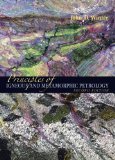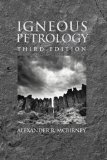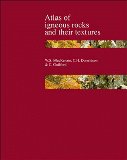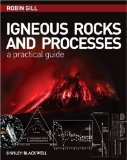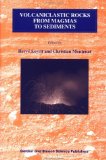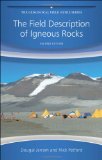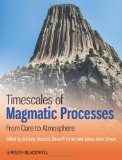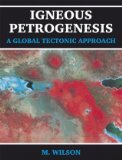Igneous rocks
- A comparative study on two trondhjemitic rock-series of different origin from the Mureş ophiolitic suture, Romania

- A database of plagioclase crystal preferred orientations (CPO) and microstructures – implications for CPO origin, strength, symmetry and seismic anisotropy in gabbroic rocks

- Advective heat transfer and fabric development in a shallow crustal intrusive granite – the case of Proterozoic Vellaturu granite, south India

- AFC-Modeler: a Microsoft® Excel© workbook program for modelling assimilation combined with fractional crystallization (AFC) process in magmatic systems by using equations of DePaolo (1981)

- Al-in-Hornblende Thermobarometry and Sr-Nd-O-Pb Isotopic Compositions of the Early Miocene Alaçam Granite in NW Anatolia (Turkey)

- Anatectic migmatites from the roof of an ocean ridge magma chamber

- Arc Basalt Simulator version 2, a simulation for slab dehydration and fluid-fluxed mantle melting for arc basalts: Modeling scheme and application

- Archaean Zircon U-Pb Age Paradox in Juvenile Neoproterozoic Granitoids, Central North Sudan, Saharan Metacraton

- Basalt 2013 - Cenozoic Magmatism in Central Europe - April 24-28 2013, Goerlitz, Germany
- Characteristics of pegmatoidal granite exposed near Bayalan, Ajmer district, Rajasthan

- Chromite-hosted Silicate Melt Inclusions from Basalts in the Stravaj Complex, Southern Mirdita Ophiolite Belt (Albania)

- Chronology and petrogenesis of the Hejiazhuang granitoid pluton and its constraints on the Early Triassic tectonic evolution of the South Qinling Belt

- Classification of Granitic Pegmatites Revisited

- Clinopyroxene from basaltic rocks of the Erzgebirge - Krušné hory Mts. - implications for modelling the magmatic plumbing system

- Comparison of geological, textural and petrographic characteristics of the pillow lava flows from the areas of Malo Buchino, Babitsa and Nеdelkovo villages (Western Srednogorie)

- Complete preservation of ophiolite suite from south Andaman, India: A mineralchemical perspective

- Compositional diversity of Eocene-Oligocene basaltic magmatism in the Eastern Rhodopes, SE Bulgaria: implications for genesis and tectonic setting

- Compositional Variations, Zoning Types and Petrogenetic Implications of Low-pressure Clinopyroxenes in the Neogene Alkaline Volcanic Rocks of Northeastern Turkey

- Contemporaneous Late Cretaceous Calc-alkaline and Alkaline Magmatism in Central Anatolia, Turkey: O Isotope Constraints on Petrogenesis

- Continental margin ophiolites of Neotethys: Remnants of Ancient Ocean–Continent Transition Zone (OCTZ) lithosphere and their geochemistry, mantle sources and melt evolution patterns

- Contrasting magmatic signatures in the Rairakhol and Koraput alkaline complexes, Eastern Ghats belt, India

- Death of super-continents and birth of oceans heralded by discrete A-type granite igneous events: the case of the Variscan-Alpine Europe

- Different Degrees of Partial Melting of the Enriched Mantle Source for Plio−Quaternary Basic Volcanism, Toprakkale (Osmaniye) Region, Southern Turkey

- Digital Concentration-Distribution Models – tools for a describing heterogeneity of the hybridized magmatic mass as reflected in elemental concentration of growing crystal

- Dikili-Çandarlı Volcanics, Western Turkey: Magmatic Interactions as Recorded by Petrographic and Geochemical Features

- Discriminating four tectonic settings: Five new geochemical diagrams for basic and ultrabasic volcanic rocks based on log–ratio transformation of major-element data

- Evaluation of a permeability-porosity relationship in a low permeability creeping material using a single transient test

- Felsic tuff from Rutland Island – A pyroclastic flow deposit in Miocene-sediments of Andaman-Java subduction complex

- Flood basalts, mantle plumes and mass extinctions
- Fluid mechanics inside a volcano

- Fore-arc basalts and subduction initiation in the Izu-Bonin-Mariana system

- From basalts to boninites: the geodynamics of volcanic expression during subduction initiation

- Garnet pyroxenite in the Biskupice peridotite, Bohemian Massif: anatomy of a Variscan high-pressure cumulate

- Geochemical and isotopic (Sr, Nd and O) constraints on sources for Variscan granites in the Western Carpathians - implications for crustal structure and tectonics

- Geochemical and Isotopic Constraints on Petrogenesis of the Beypazarı Granitoid, NW Ankara, Western Central Anatolia, Turkey

- Geochemical and Sm–Nd isotopic study of titanite from granitoid rocks of the eastern Dharwar craton, southern India

- Geochemical and Sr-Nd Isotopic Characteristics of Post-Collisional Calc-Alkaline Volcanics in the Eastern Pontides (NE Turkey)

- Geochemical and temporal evolution of Cenozoic magmatism in Western Turkey: Mantle response to collision, slab break-off, and lithospheric tearing in an orogenic belt

- Geochemical Characteristics of Mafic and Intermediate Volcanic Rocks from the Hasandağ and Erciyes Volcanoes (Central Anatolia, Turkey)

- Geochemical characteristics of Mesoproterozoic metabasite dykes from the Chhotanagpur Gneissic Terrain, eastern India: Implications for their emplacement in a plate margin tectonic environment

- Geochemical study of volcanic and associated granitic rocks from Endau Rompin, Johor, Peninsular Malaysia

- Geochemistry and petrogenesis of Neoproterozoic Mylliem granitoids, Meghalaya Plateau, northeastern India

- Geochemistry and petrology of the ophiolitic rocks from the Kahramanmaraş region, southern Turkey

- Geochemistry and petrology of pyroxenite xenoliths from Cenozoic alkaline basalts, Bohemian Massif

- Geochemistry and Tectonic Environment of Diverse Magma Generations Forming the Crustal Units of the Kızıldağ (Hatay) Ophiolite, Southern Turkey

- Geochemistry of abyssal peridotites from the super slow-spreading Southwest Indian Ridge near 65°E: Implications for magma source and seawater alteration

- Geochemistry of Igneous Rocks
- Geochemistry of the Jurassic Mirdita Ophiolite (Albania) and the MORB to SSZ evolution of a marginal basin oceanic crust

- Geochemistry of the Middle Miocene Collision-Related Yamadaği ( Eastern Anatolia) Calc-Alkaline Volcanics, Turkey

- Geological characteristics and setting of ophiolitic mélange around Tokat (Dumanli dagh) and Sivas (Çeltek dagh) region

- Geological characteristics and structural evolution of the ophiolitic units around Sakaltutan Dagi (Erzurum)

- Geological position, mineral assemblages and contamination of granitic pegmatites in the Moldanubian Zone, Czech Republic; examples from the Vlastějovice region

- Global pulsations of intraplate magmatism through the Cenozoic, Lithosphere

- How To Know About Igneous Rocks

- Hurst exponent as a tool for the description of magma field heterogeneity reflected in the geochemistry of growing crystals

- Hydrothermal alteration studies of gabbros from Northern Central Indian Ridge and their geodynamic implications

- Hydrothermal insights from the Troodos ophiolite, Cyprus

- Hydrothermally Opalized Serpentinites in Tethyan Ophiolite Sequence in Central Serbia

- Igneous Geochemistry
- Igneous Petrology (Geo301)
- Igneous rocks (Geology 200a)
- Igneous Rocks
- Igneous Rocks

- Igneous Rocks Home Page
- Igneous Rock Identification Exercise
- Inner structure and age of emplacement of the ophiolitic mélange between Tokat and Sivas provinces

- Intrusive Igneous Rocks
- Late Devonian and Triassic basalts from the southern continental margin of the East European Platform, tracers of a single heterogeneous lithospheric mantle source

- Layering and schlieren in granitoids: A record of interactions between magma emplacement, crystallization and deformation in growing plutons (The André Dumont medallist lecture)

- Mafic-Ultramafic Large Igneous Provinces (LIPs): Importance of the Pre-Mesozoic record

- Magma Interaction Processes Inferred from Fe-Ti Oxide Compositions in the Dölek and Sarıçiçek Plutons, Eastern Turkey

- Magma Interaction Recorded in Plagioclase Zoning in Granitoid Systems, Zigana Granitoid, Eastern Pontides, Turkey

- Magmatic dyke systems of the South Shetland Islands volcanic arc (West Antarctica): reflections of the geodynamic history

- Magmatic processes at the volcanic front of Central Mexican Volcanic Belt: Sierra de Chichinautzin Volcanic Field (Mexico)

- Mantle plume activity and melting conditions: Evidence from olivines in picritic-komatiitic rocks from the Emeishan Large Igneous Province, southwestern China

- Microtextural and mineral chemical analyses of andesite–dacite from Barren and Narcondam islands: Evidences for magma mixing and petrological implications

- Migrating shoshonitic magmatism tracks Izu-Bonin- Mariana intra-oceanic arc rift propagation

- Mineral and Whole-rock Geochemistry of the Kestanbol Granitoid (Ezine-Çanakkale) and its Mafic Microgranular Enclaves in Northwestern Anatolia: Evidence of Felsic and Mafic Magma Interaction

- Mineral Chemistry and Petrochemistry of Post-Collisional Tertiary Mafic to Felsic Cogenetic Volcanics in the Ulubey (Ordu) Area, Eastern Pontides, NE Turkey

- Mineral chemistry of lava flows from Linga area of the Eastern Deccan Volcanic Province, India

- Mineral chemistry of Pangidi basalt flows from Andhra Pradesh

- Missing link between granites and granitic pegmatites

- Modification of magnetic properties in granite during hydrothermal alteration (EPS-1 borehole, Upper Rhine Graben)

- Nature and efficiency of pyroclast generation from porous magma: Insights from field investigations and laboratory experiments

- Neoproterozoic Ophiolites of the Arabian-Nubian Shield

- Non-explosive interaction of magma and wet unconsolidated volcaniclastics: case study from the Sushevo trachydacite cryptodomes, East Rhodopes

- Non-Newtonian effects in silicate liquids and crystal bearing melts: Implication for magma dynamics

- North Atlantic Igneous province
- Ophiolites and Ophiolitic Melanges of Turkey: A Review

- Ophiolitic Molasse Unit of Ikaria Island (Greece)

- Organization of volcanic plumbing through magmatic lensing by magma chambers and volcanic loads

- Origin of Back-arc Basin Magmas: Trace Element and Isotopic Perspectives

- Origin of mantle peridotites from the Vourinos Ophiolite Complex, Greece, as deduced from Cr-spinel morphological and chemical variations

- Overview of the genesis and emplacement of Mesozoic ophiolites in the Eastern Mediterranean Tethyan region

- Paleo-thermal Effects of Igneous Intrusions in Sedimentary Basins and Their Influence on Petroleum Systems

- Peridotites derived from a ductile shear zone within backarc lithospheric mantle, southern Mariana Trench: results of a Shinkai 6500 dive

- Petrogenesis of Late Cretaceous Adakitic Magmatism in the İstanbul Zone (Çavuşbaşı Granodiorite, NW Turkey)

- Petrogenesis of the Kösedağ Pluton, Suşehri-NE Sivas, East-Central Pontides, Turkey

- Petrogenesis of the Refahiye Ophiolite and its Tectonic Significance for Neotethyan Ophiolites Along the İzmir-Ankara-Erzincan Suture Zone

- Petrographic and mineralogical characterisation of fractionated pegmatites culminating in the Nb-Ta-Sn pegmatites of the Gatumba area (western Rwanda)

- Petrography and Petrology of the Calc-Alkaline Sarıhan Granitoid (NE Turkey): An Example of Magma Mingling and Mixing

- Pétrologie Endogene
- Petrology, geochemistry of hornblende gabbro and associated dolerite dyke of Paharpur, Puruliya, West Bengal: Implication for petrogenetic process and tectonic setting

- Petrology of the İspendere (Malatya) ophiolite from the Southeast Anatolia: implications for the Late Mesozoic evolution of the southern Neotethyan ocean

- PETROMODELER (Petrological Modeler): a Microsoft® Excel© spreadsheet program for modelling melting, mixing, crystallization and assimilation processes in magmatic systems

- Petrophysical and geochemical characteristics of late Variscan granites in the Karlovy Vary Massif (Czech Republic) - implications for gravity and magnetic interpretation in shallow depths

- PETROS Igneous Petrology Databank
- Pre-ocean and post-collision intraplate basalts from Romania: A comparative study

- Pyroclastic stratigraphy of the acid volcaniclastics (2-nd Rupelian phase) near Plazishte (Dzhebel) and Kostino (Kardzhali) villages, Eastern Rhodopes – a comparative study

- Rapid emplacement of the Oman ophiolite: Thermal and geochronologic onstraints

- Rapid emplacement of young oceanic lithosphere: Argon geochronology of the Oman ophiolite

- Relationship between chemical composition and magnetic susceptibility in the alkaline volcanics from the Isparta area, SW Turkey

- Roches et minéraux magmatiques
- Role of serpentinites in cycling of carbon and sulfur: Seafloor serpentinization and subduction metamorphism

- Seismic interpretation and characterization of igneous rocks in Jan Mayen Microcontinent, Norwegian-Greenland Sea

- Serpentinization and carbon sequestration: A study of two ancient peridotite-hosted hydrothermal systems

- Sidi Mohamed peridotites (Edough Massif, NE Algeria): Evidence for an upper mantle origin

- Silicic Large Igneous Provinces

- Source and Petrogenesis of the Igneous Complex Cored during ODP Leg 205: Implications for Off-Axis Plume-Ridge Interaction on the Cocos Plate

- Sr and Nd Isotopic Characteristics of Some S-, I- and A-type Granitoids from Central Anatolia

- Statistical Evaluation of Classification Diagrams for Altered Igneous Rocks

- Stratigraphy and Geochemical Features of the Early Miocene Bimodal (Ultrapotassic and Calc-alkaline) Volcanic Activity Within the NE-trending Selendi Basin, Western Anatolia, Turkey

- Studies of Magmatic Systems

- Studies of volatile evolution in magmatic systems using melt inclusions

- 'Subduction initiation rule': A key for linking ophiolites, intra-oceanic forearcs and subduction initiation

- Sulfur geochemistry of peridotite-hosted hydrothermal systems: Comparing the Ligurian ophiolites with oceanic serpentinites

- Suprasubduction zone ophiolite formation along the periphery of Mesozoic Gondwana

- Suprasubduction zone ophiolites and Archean tectonics

- Tectonic implications of ca. 1.45 Ga granitoid magmatism at the southwestern margin of the East European Craton

- Tectonic Implications of Some Cretaceous Pillow Basalts from the North Anatolian Ophiolitic Mélange(Central Anatolia-Turkey) to the Evolution of Neotethys

- Textural and Compositional Evidence for Magma Mixing in the Evolution of the Çamlıdere Volcanic Rocks (Galatean Volcanic Province), Central Anatolia, Turkey

- Two Primary Basalt Magmatypes from Northwest Rota-1 Volcano, Mariana Arc

- U-Pb zircon SHRIMP ages, geochemical and Sr-Nd isotopic compositions of the Early Cretaceous I-type Sarıosman pluton, Eastern Pontides, NE Turkey

- Understanding silicic volcanism: Constraints from elasticity and failure of vesicular magma

- Uptake of carbon and sulfur during seafloor serpentinization and the effects of subduction metamorphism in Ligurian peridotites

- Volcanic Rocks From Foça-Karaburun and Ayvalik-Lesvos grabens (Western Anatolia) and Their Petrogenetic-Geodynamic Significance

- Water-rich basalts at mid-ocean-ridge cold spots

- Whole Rock and Mineral Chemistry of Ultramafic-mafic Cumulates from the Orhaneli (Bursa) Ophiolite, NW Anatolia

Books about igneous rocks
